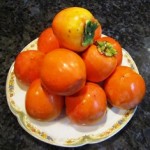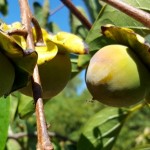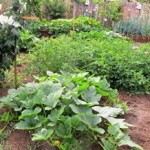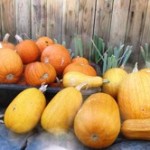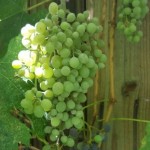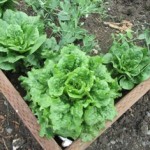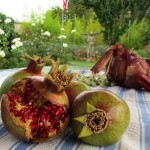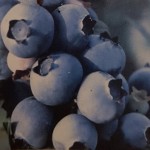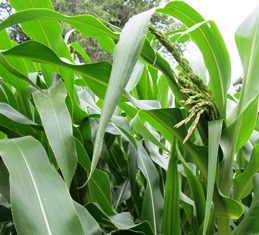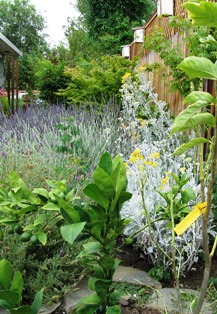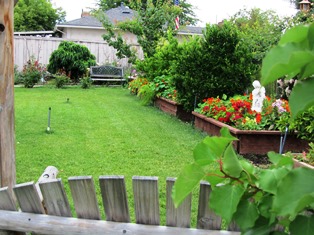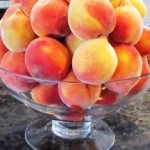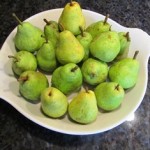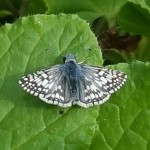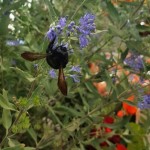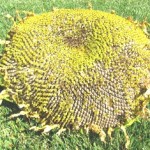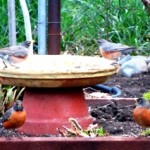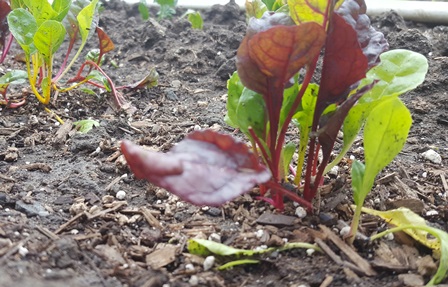Archive for the 'Gardening' Category
Fruit Drop with Young Hachiya Persimmon Trees
My three-year-old Hachiya persimmon tree was loaded with fruit but recently went through a huge fruit drop. Possibly the long stretch of triple-digit summer heat coupled with the tree not getting enough water may have caused this problem. Young trees are more prone to fruit drop than trees that are mature.
I find the fruit drop disconcerting because Hachiyas are my favorite persimmons. It did the same thing last year.
Each autumn, I wait with anticipation watching the fruit and checking it often until October for ripeness. This fruit is highly astringent so must be eaten ripe. The fruit texture is like jelly with a sweet and slightly spicy flavor.
Besides the fruit, what I like about this persimmon is that it becomes a showstopper in the fall with red, gold, or yellow leaves. During winter, the fruit hangs on the tree like ornamentation.
The Hachiya trees are not much bothered by pests or disease. They require at least a half day’s sun and well drained soil. These trees grow to 15 to 20 feet tall. They make great landscape trees and the fruit is a wonderful bonus.
______________________________________________________
If you enjoy reading about growing fruit trees or heirloom plants or trying delicious recipes or keeping bees and chickens and you like a mysteries, check out my Henny Penny Farmette series of cozy mysteries from Kensington Publishing in NY. They’re available online and in traditional bookstores everywhere.

A HIVE OF HOMICIDES is the newest offering in the Henny Penny Farmette series; available Sept. 26, 2017
Currently, A HIVE OF HOMICIDES is a featured title in Barnes & Noble’s September promotional BUY 3, GET 1 FREE sale.
WHAT IS THE BUY 3, GET 1 FREE OFFER?
Everyone who buys a Kensington cozy mystery from the B&N in-store display or any Kensington cozy mystery from BarnesandNoble.com between 9/5/17 – 10/5/17 and registers their purchase at http://sites.kensingtonbooks.com/kensingtoncozies/BN/ will:
— Automatically be entered into Kensington’s “Cozy Mystery Bonanza” sweepstakes for a chance to win a $300 value gift basket. One grand prize winner will be selected after the sale has concluded.
— Automatically receive a free Kensington Cozies recipe booklet plus a download code for the novel A STORY TO KILL by Lynn Cahoon after the sale has concluded.
* * *
DON’T FORGET TO ENTER THE FREE DRAWING AT GOODREADS.COM.
Win a signed copy of A Hive of Homicides along with a gorgeous reversible apron and a set of 2 chicken napkin rings. Enter before September 26 for a chance to win.
See, https://www.goodreads.com/book/show/33911114-a-hive-of-homicides?from_search=true
Helping a Kitchen Garden to Grow in Clay Soil
Under the searing summer sun, the clay soil of my farmette will grow amazing pin oaks, white oaks, and pine trees. But for a gardener like me who wants to grow vegetables and herbs, clay soil frustrates and challenges.
Before planting next year’s kitchen garden in a new area of the property, I’ll have to change the soil structure now. This will take time and a lot of effort, but it will pay huge dividends over the long term.
Here are a few things things a gardener can do to improve clay soil.
1. A few weeks before working an area, mulch the area with an eight to ten-inch layer of wood chips to help the soil retain moisture and regain structure.
2. Use a pickax to break up the soil to the depth of 10 inches and work in composted organic material.
3. Avoid working the soil after a rain or when the ground is wet because the soil will ball up into unwieldy clumps.
4. Work in sand or perlite to create more pore space for aeration and drainage. Beware of adding too much sand; the soil becomes like concrete. Ideally, the soil should have roughly fifty percent pore space with minerals and organic matter filling in the rest.
5. When not growing plants, sow a cover crop of legumes to reduce weed germination, prevent erosion, and help water penetrate deeply into the soil. A legume cover crop provides plant matter that can be turned back into the soil or mowed, leaving the plant’s bio mass in place. Legumes fix the nitrogen in the soil that will nourish the plants of the kitchen garden.
6. Repeat all of the above steps annually and dig, turn, rake, and water. Over time, the soil should support healthy roots of plants and give you a robust kitchen garden that will provide many tasty vegetables and culinary herbs.
____________________________________________________________________
If you enjoy reading cozy mysteries and are interested in gardening/farming topics, keeping bees and chickens, or creating delicious recipes from heirloom vegetables and herbs, check out my Henny Penny Farmette series. All are available from Amazon, Barnes and Noble, and other traditional and online bookstores everywhere.
Coming 9/27/17
PUBLISHERS WEEKLY 08/14/2017 noted:
“Lester’s sensitive portrayal of Abby’s struggle with her wounded psyche raises this traditional mystery above the pack.”
See more at: https://www.barnesandnoble.com/w/a-hive-of-homicides-meera-lester/1125424538?type=eBook
The Summer Garden Is Done, What’s Next?
My summer garden is wild and chaotic and bountiful at the beginning of the season. You’ll find fruit trees, vegetables, vines of melons, corn, and perennial lavender and other showy herbs and flowers. Like a grand dame of faded elegance, the garden has matured and looks a bit weary and spent now that Labor Day approaches.
Just because the peak growing season is coming to an end, it’s not the end of garden chores. The following tasks can be started now.
HARVEST AND STORE
For some crops, the harvesting goes on. Examples include tomatoes, potatoes, melons, and winter squashes like Butternut that store well. If you haven’t already harvested the garlic, it’s a good time to do that.
Cut sunflower seed heads and place them in a warm area to dry. Collect seeds from cosmos, nasturtiums, and other flowers to preserve for next year’s garden. Work out storage options, especially for food items to be harvested.
Snip summer table grapes and other varieties if they are ripe . . . or let them hang a while longer for extra sweetness.
CLEAR BEDS
Depleted, dying, or dried annuals can be dug, pulled, and composted now. If you plan to let the garden rest, plant a cover crop so the ground doesn’t become hard scrabble. The cover crop will feed the soil.
DO FALL PLANTING
If you intend to do a fall planting, take time now to enrich the earth with amendments. Turn and rake the garden soil. Put plants directly into the prepared earth and water well to get them off to a good start.
For quick second crop before the weather turns cold, plant greens such as spinach, kale, and arugula. Cool season crops like beets, broccoli, and cabbage can go directly into the ground now, too.
CUT FLOWER AND SEED HEADS
Cut flower heads of hydrangeas for drying. Insert plant markers near peonies and other perennials that will die completely back during winter. Gather bunches of mint and other herbs, tie with string, an hang in a cool, dark place to dry.
CREATE MULCH
Designate an area to create a new compost pile. Use garden detritus and fall leaves as the trees begin to drop their canopies to enter winter dormancy. The resulting mulch will enrich the soil for next year’s garden.
CHECK ON FALL PRODUCE
Pomegranates, persimmons, and pumpkins will soon be ripening. Ensure that these plants continue to get water. Check for pests and any signs that might indicate nutrient deficiencies that could show up in the leaves. Figure out your options for storing or gifting excess fruits and veggies. For example, pomegranates keep well in the fridge or remove the seeds and put into bags for freezing. Save and dry rinds for potpourri.
TURN THE SOIL IN GROW BOXES
Aerate and amend soil in grow boxes and raised beds for cool season crops. Do these chores before the rainy season and cool weather arrives. Your garden, like a young maiden who flourishes from attention, will produce bountiful vegetables, fruits, berries, and flowers during its next growing season.
_______________________________________________________________
If you enjoy reading about farmette topics, gardening, and keeping chickens and honeybees, check out my series of cozy mysteries from Kensington Publishing in New York.
Click on this link: http://tinyurl.com/ya5vhhpm
My newest nonfiction book is published by Adams Media/Simon & Schuster: http://tinyurl.com/y9vfw2t9
- Anyone can find peace, clarity, and focus…all it takes is a moment
Growing Blueberries in the Bay Area
My Henny Penny Farmette is not far removed from ranch land populated by cows and dotted with towering oaks and pines. In the blistering heat of summer, the surrounding hills and canyons support little more than star thistle and wild grass that dries to become the perfect tinder for wildfires. Until recently, I doubted I could ever successfully grow blueberries that need the moist, acidic soils, more common to the Northeast and deep South.
However, after reading the University of California paper on growing blueberries here in the West, especially in the nearby Central Valley and also the Santa Clara Valley, I decided to try a couple of plants. See, http://ucce.ucdavis.edu/files/filelibrary/5842/25993.pdf.
I chose to grow Sharpblue (a southern highbush type of blueberry). These plants have beautiful blue-green foliage and a compact growing habit. When they reach their full height, they will stand 6-8 feet high and 4-6 feet wide. The plants are self-fertile.
This plant produces both flowers and fruit throughout most of the year; the fruit can be picked from midsummer through the fall. To my surprise, the plant bore fruit this year.
Northern lowbush blueberries grow well in northern U.S. states and in Canada where moist soil and long hours of winter chilling fulfill the plant’s growing requirements.
For best results in the Bay Area, choose highbush blueberries such as the following: Sharpblue, Sunshine Blue, Bluecrop, Blueray, Ozark Blue, Georgia Gem, Misty, Reveille, Cape Fear, and O’Neal. Plant them in acid soil that drains well and is porous.
They may also be planted in containers on patios but require plenty of water and six hours of sun. In the hottest areas, provide part sun/shade.
Blueberries taste great in pancakes, muffins, strudels, and coffee cakes. They’re delicious in jams or stirred into yogurt (my favorite). Just a single cup of this low-cal fruit is packed with Vitamin C, fiber, and antioxidants. Freeze extra berries to enjoy later.
Try making this taste-pleasing recipe posted online at WebMD.com for Blueberry Nectarine Granola Crisp. See, http://www.webmd.com/food-recipes/features/blueberries-nutritious-things-come-in-small-packages_
_______________________________________________________________
If you enjoy reading about farmette topics, gardening, and keeping chickens and honeybees, check out my series of cozy mysteries from Kensington Publishing in New York.
Click on this link: http://tinyurl.com/ya5vhhpm
Click on this link to see The MURDER OF A QUEEN BEE: Click on this link: http://tinyurl.com/yd7pz7af
Harvesting Garlic
Now that it’s the last week of July, the garlic in my Henny Penny Farmette garden is showing signs of maturation. When the bottom stalk leaves turn brown and dry, it’s an indicator that the bulbs beneath the soil are ready for harvesting.
Garlic is easy to grow, harvest, cure, and store. If you like to cook, you already know how important garlic is as a culinary staple. Since it doesn’t require much space, you can grow it in a large pot or flower box on your patio. It’s well worth your time and effort.
The leaves of a garlic plant sprout from the bottom of the stem upward. The oldest bottom leaves will indicate maturity of the bulbs.
Use a fork to carefully loosen soil around the base of each garlic plant. It’s a good idea not to pull from the stems as they might snap. You don’t want to bruise or otherwise damage the garlic bulbs.
Once the plants are harvested, you’ll need to cure them by drying them in a cool, dark place. You could also tie them by their stems in small allotments and hang in protected shed or ventilated closet where the air can circulate around the bulbs.
- Cloves of garlic ready to be peeled and prepared for cooking
When the garlic has been cured, remove any remaining soil. Braid the stems to hang the bulbs in your kitchen for easy access when cooking (these braids also make great gifts to friends who cook). Or, leave about 1/2 inch of stem in place before cutting off the rest and storing the garlic in a cool, dark, place.
Softneck Garlic: This type of garlic is preferred for braiding and includes the varieties of Creole, artichoke, and some Asian types of garlic. Softneck garlic grows best where winters are mild and this type of garlic stores for a longer period of time than hardneck types.
Hardneck Garlic: If you want garlic adaptable to cold winter climates and a taste that is closer to wild garlic, this is the type of garlic of choose. It includes the rocambole, purple stripe, and porcelain varieties.
_______________________________________________________________
If you enjoy reading about farmette topics, gardening, and keeping chickens and honeybees, check out my series of cozy mysteries from Kensington Publishing in New York.
Click on this link: http://tinyurl.com/ya5vhhpm
Click on this link: http://tinyurl.com/yd7pz7af
Edible Landscape: Our Garden of Gentle Disorder
I’ve long been enamored of the traditional French jardin potager or ornamental, vegetable kitchen garden. The kitchen garden has its roots the medieval jardin de curé, described by garden author Jean-Paul Collaert in Kitchen Gardens of France, by Louisa James (Thames and Hudson 1999), as a “garden of lines . . . not dabs of color” as opposed to the English cottage garden and the traditional vicarage garden.
Most potagers grow the traditional four types of plants: vegetables, fruit, flowers, and herbs. What I love is the revival of interest worldwide in heirloom fruits and vegetables, which are perfectly suited for a kitchen garden. On my farmette, I grow plants almost exclusively from heirloom seed.
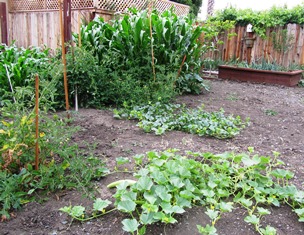
Corn, cucumber, and tomatoes share ground space; onions, garden peas, and eggplants thrive in boxes, table grapes spill over the fence
The medieval jardin de curé has been characterized by scholars as having plants in distinct beds laid out along formal lines (the Latin cross was popular). Gardening plots were defined by ge0metric shapes that could be quite complex (for example, the historic knot garden). Plants included herbs and flowers (many for medicinal uses), vegetables, berries, fruit trees, and ornamental trees and shrubs. This type of garden could be rustic or highly formal and could be found throughout France, from small farms and cloisters to country estates.
Our farmette garden has characteristics of the jardin potager and also the jardin de curé, although it could not be described as a true representation of either.
When we first moved to the farmette, we created and followed a master plan. The acreage follows a large rectangular-shape perimeter with our small house situated in the middle. Behind the house, a lawn is lined with gravel pathways. The pathways are dotted with boxes of herbs and flowers, mint, and berries. Between the boxes, the apricot, cherry, apple, fig, and persimmon trees are flourishing and producing bountiful crops.
In chaotic disorder, the beds of French perfume lavender and Spanish lavender that we planted have taken over one side of the property (much to the delight our honeybees), effectively erasing any lines that might have been obvious in an early layout. Interspersed with the lavender beds are iris, hydrangea, roses, lemon trees. Where the lavender turns a corner, bamboo creates a privacy screen, and then the fruit and flower-lined gravel path continues to the chicken house.
We moved dirt from the back half of the property and built a retaining wall along an L-shaped gravel path leading to a vegetable garden. Both sides of the path are lined with trees–apricot, pear, and pomegranate. On one side under a massive elm is a bed containing white geraniums and a variety of rose bushes.
We are following a plan for our own vision of a potager and, although I wish it had more of the lines of the medieval jardin de curé, our garden has the appearance of gentle disorder while being a prolific producer, in short, an edible landscape.
I love this living tableau. The appearance of the garden and grounds changes with the cycles of the seasons. Also ever-changing are the types of wildlife and songbirds frequenting the fountains and foraging on the fruits. There’s always something new to discover.
__________________________________________________________________
If you enjoy reading about farmette topics, gardening, and keeping chickens and honeybees, check out my series of cozy mysteries from Kensington Publishing in New York. Click on the link.
A HIVE OF HOMICIDES
Swimming in Fruit
Our cherry trees became so heavily laden with fruit this year I couldn’t work fast enough to make the fruit into cookies and pies and jars of jam, conserve, and chutney.
What fruit the birds and squirrels didn’t devour ended up drying on the trees and looking like ornaments. I’m heartened that at least the wildlife will have something to forage on through fall and winter.
The apricot trees did a massive drop of their fruit and seemingly all at once. I made more jam than we’ll probably eat, dried some, and gave away more than a few full buckets of cots to neighbors and friends. I also had to do a messy cleanup of fruit on the ground.
In the cycle now are the summer peaches; so, here I go again . . swimming in fruit.
Next year, I’m going to get my act together early with teams of backyard pickers who can help me remove the fruit, divide it, and distribute it. Right now, however, I’ve got peaches to pick and preserve. The summer pears and figs will be next.
I’m not complaining; I’m enthralled that all this bounty is due to the work of our industrious little honeybees. All this fruit and I haven’t even mentioned finding time to harvest honey. Yet, the bees don’t stop, so neither will I.
________________________________________________________________
If you enjoy reading about farmette topics like keeping bees and chickens, caring for an orchard, or growing heirloom herbs and vegetables, check out my mystery series from Kensington Publishing (due out September 26, 2017).
These novels feature a whodunnit for you to solve and are filled with farming facts, trivia, and delicious recipes. The novels and my other books are available in traditional and online bookstores everywhere. See, http://tinyurl.com/yb42zd2d
Plant for the Pollinators
I seldom need an occasion to put in another bed of flowers, but this is National Pollinator Week. I think a new bed is in order to attract local bees, birds, bats, and butterflies–all considered pollinators. Having these small creatures around benefits landscapes, gardens, and orchards.
The U.S. Fish and Wildlife Service has noted that over 75 percent of our plants are pollinated by birds, animals, and insects. We can help ensure these creatures will be around for a long time if we restore their habitats and ensure they have food and water.
There are many lovely plants you can grow that don’t require a lot of care.
- lavender
- bee balm
- echinacea
- sage
- cilantro
- thyme
- sunflowers
- sweet alyssum
- anemone
- borage
- geraniums
- scented pelargoniums
- mint
A tapestry of colorful herbs and flowers beautifies your landscape and pollinators love the diversity. If you don’t have a lot of space, grow some of these plants in planter boxes, clay pots, or other types of containers.
Put in a water feature, too, such as a table-top or larger fountain that recycles water. Even a pottery saucer filled each day can attract pollinators.
It won’t take long for the bees and hummingbirds to find the water. Their frequent visits are fun to watch, and they’ll likely be sipping throughout the day.
_________________________________________________________________________
If you enjoy reading about farmette topics, check out my Henny Penny Farmette series of cozy mysteries from Kensington Publishing. My newest novel includes delicious recipes, tips on keeping bees and chickens, and much more. Click on this URL for more information, http://tinyurl.com/ya5vhhpm
.
Grow Seasonal Greens Now
The cool season of spring is the optimum time to grow seasonal greens for salads and healthy blended shakes. In my kitchen garden, I’ve planted a variety of lettuces, spinach, kale, and chard. Most salad greens are easy to grow also in containers, raised beds, and window boxes when gardening space is limited.
Add compost and aged chicken manure to enrich the soil with nitrogen. Plant heirloom seeds about 1/2 inch in the soil, cover, and water. Within a week or 10 days, you should see the seedlings pop up. The greens will be ready to pick in about 25 days.
Water the plants to keep them hydrated but don’t drown the plants. When you are ready to make a salad, snip the leaves you want with kitchen scissors. New leaves will soon form if the roots are not disturbed and the plant continues to get nutrients and water.
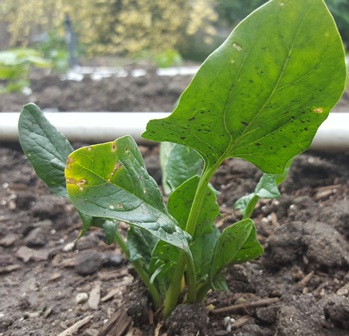
Spinach can be started in seed cell flats and then transplanted into your garden when all danger of frost has passed
SALAD OF FRESH GREENS
1. Snip a variety of greens in the early morning. Wash and thoroughly dry the leaves.
2. Place them in a bowl and crumble on some sharp cheese such as your favorite goat cheese or a Gargonzola (blue-veined, sharp tasting, and crumbly).
3. Add 1/2 cup sugared or candied walnuts.
4. Add some slice red onion and a handful of dried cranberries or chopped dried apricots.
5. Drop into the bowl some slices of a pear such as Bosc (considered the prince of pears).
6. Gently toss the salad and then spritz with red wine vinaigrette prior to plating on pretty salad serving dishes.
* * *
If you love reading about gardening and other farming topics, check out my Henny Penny Farmette series of cozy mysteries that include A BEELINE TO MURDER, THE MURDER OF A QUEEN BEE, and A HIVE OF HOMICIDES.
-
Delicious recipes
-
Farm quips and quotes
-
Tips for gardening and keeping chickens and bees
-
An exciting whodunnit mystery
How to Grow a Fruit Tree from a Pit
Nothing beats a breakfast of summer fruit picked fresh from a patio or backyard tree. I’m referring to fruit trees such as apricots, peaches, and nectarines. Cherries and plums are also among my favorites. The fruit from these trees is often referred to as stone fruit because of the hard pits (holding the seed) around which the fruit forms.
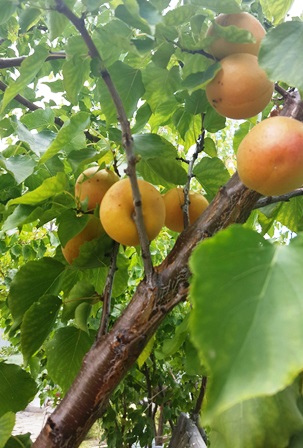
By mid-May, ripe apricots hanging on the trees in my backyard don’t last long–they’re eaten fresh, made into jams, and dried
Apricots in the Bay Area ripen in mid-May and peaches often ripen a bit later during the three months of summer (depending on the cultivar). If you love eating the fruit, don’t toss the pits. Consider that an apricot or peach grafted onto rootstock might cost upwards of $20 during bare-root season but $35 to $50 if sold in a pot. Growing from seed costs nothing.
Planting the seed extracted from the pit of your favorite apricot or peach variety can generate a tree with a very good chance of carrying the parent trees’ traits and producing fruit within three to five years. In fact, I’ve found that pits of my apricot, cherry, wild plum, peach, and nectarines that are left on the ground or discarded by the squirrels who’ve eaten the fruit will often sprout on their own.
Use this ten-step method to grow a peach or apricot tree from seed.
1. Choose a pit from a locally grown ripe fruit that tastes juicy and delicious.
2. Dry the seed on a paper towel in your kitchen window for several days.
3. Carefully crack open the hard shell of the pit to reveal the seed inside (it will resemble an almond).
4. Put the seed (or several seeds) in a sealed container in your refrigerator and let it chill for up to three months. The cool temperature exposure helps the seed get ready to sprout.
5. Time your removal of the seed from the refrigerator to a month before the last frost date in your area.
6. Cover the seed in water overnight and in the morning plant it a clear glass jar of potting soil (no lid on the jar).
7. Return the jar to the refrigerator and keep the seed moist until it has sprouted (about one month).
8. When the outside weather conditions are right (no more frost and the soil begins to warm), plant the seedling in your garden in fertile, well-drained soil.
9. Dig a basin around the planting hole for watering.
10. Mulch to keep down weeds and ensure the roots stay cool. In three years, watch for blossoms in the spring with fruit to follow.
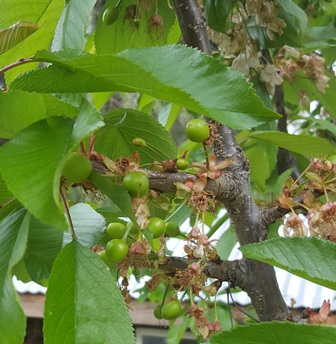
Cherry pits are much smaller than other stone fruit; pits of sour cherries (and also wild plums) may self-seed but sweet cherries less so. Cherries must have a period of cold to germinate
* * *
If you enjoy farmette topics like gardening heirloom vegetables, herbs, and fruits as well as keeping chickens and bees, check out my Henny Penny Farmette series of cozy mysteries from Kensington Publishing–A Beeline to Murder, The Murder of a Queen Bee, and A Hive of Homicides.
You’ll find in the Henny Penny Farmette series
-
Delicious recipes
-
Farm quips and quotes
-
Tips for gardening and keeping chickens and bees
-
An exciting whodunnit mystery
Also, check out MY POCKET MEDITATIONS, my newest forthcoming nonfiction title from Adams Media/Simon & Schuster, at http://tinyurl.com/l6lzorq
![My Pocket Meditations: Anytime Exercises for Peace, Clarity, and Focus by [Lester, Meera]](https://images-na.ssl-images-amazon.com/images/I/51GH%2BXEPc6L.jpg)
 Facebook
Facebook Goodreads
Goodreads LinkedIn
LinkedIn Meera Lester
Meera Lester Twitter
Twitter





